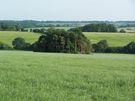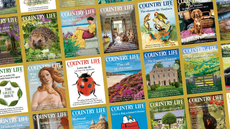Farmland booms in value
Farmland values stay buoyant despite the world's financial turmoil

In stark contrast to the continuing turmoil in the world's financial markets, the relentless upward curve of UK farmland values shows little sign of dipping in 2008. In fact, an exclusive analysis of recent trends in the UK farmland market, produced for Country Life by Savills Rural Research, suggests that Britain's top 25% of arable farms significantly outperformed all other major investment groups including UK equities in both 2006 and 2007. And in an increasingly global marketplace, rural research guru Ian Bailey expects the current surge in world demand for food and energy to further strengthen commodity prices, thereby boosting the appeal of farmland as a sound long term investment. Of the 25 countries that currently make up the EU, Ireland remains the number one hotspot in terms of farmland values, despite concern about short term liquidity problems in the Irish banking sector. Here, a chronic shortage of supply, allied to high demand from lifestyle purchasers and strong long term development potential, has sent land prices soaring to an average of almost 60,000 per hectare £18,115 per acre. With average British farmland values currently ranked at about the middle of the European league, Irish buyers have been capitalising on the high values achieved at home to increase the size of their holdings, bidding strongly for any top grade UK farms that come on the market. In 2007, Irish buyers represented 4.8% of all buyers of UK farmland, compared with 2.5% in 2006, Savills say. In Denmark, where land ownership is state regulated and opportunities for expansion limited, land values are roughly double those in England. As a result, Danish farmers have been a major force in the UK farmland market in recent years. In 2007, Danish buyers represented 10.3% of all buyers, up from 9.3% in 2006, and 37% of all buyers of farms of more than 500 acres, compared with 40% in 2006. Among home based buyers, the proportion of farmers buying land in 2007 was up for the fourth year in a row, as rising commodity prices boosted optimism and confidence within the farming community: in 2007, 82% of farmers were expanding their business, 9% were relocating and 4.5% were sitting tenants. Non-farmers the so-called lifestyle buyers representedabout 35% of purchasers in 2007, compared with 45% in 2003. The return of farming's feelgood factor was also reflected on the selling side, where the proportion of farmers selling land fell from 62.3% in 2006 to 58% in 2007. On the other hand, non-farming private landowners seemed to be more restless, representing 30.4% of sellers in 2007, compared with 25.5% in 2006. The proportion of institutional or corporate vendors rose slightly to 12% of all sellers, and debt as a reason for sale was significantly down at 5.6% in 2007, compared with 16% in 2006. The one blot on this otherwise rosy landscape is the plight of livestock producers, who aren't enjoying the same benefits as those involved in the arable sector, says Andrew Watkin of Carter Jonas, whose rural division manages more than 750,000 acres throughout England and Wales. 'With feed prices rocketing and returns dwindling, a number of producers, especially in the pig industry, are considering pulling out of farming completely. At the same time, the upturn in milk prices has brought welcome relief to dairy farmers, and with food prices on the increase, those who are in a position to weather the storm may well reap substantial rewards in the future, as consumers get used to paying prices that allow food producers, and not only retailers (such as supermarkets), to make a profit.' Mr Watkin's cautious optimism is echoed by Alex Rew of West Country agents Stags, whose patch covers some of the areas worst hit by problems in the livestock industry. He cites the recent sale of 80 acres of bare land at Drewsteignton on the edge of Dartmoor, where no fewer than seven farmers were happy to bid more than £4,000 an acre for the holding. With burgeoning demand for agricultural land unmatched by supply according to Savills, 186,000 acres were marketed across Great Britain in 2007, a similar acreage to that offered in 2006 prices rose sharply last year. In England, the average value of all types of farmland increased by 30% to about £3,700 an acre 87% higher than at the beginning of 2004. A similar increase was recorded in Scotland, where average values rose to £2,750 an acre, almost twice those of early 2004, with Scots competing for the land every bit as hard as buyers from further afield. Meanwhile, prime arable land prices in both England and Scotland topped £5,000 an acre in many cases, with sale prices of £7,000 an acre achieved in some areas. In Wales, where 9,000 acres were offered for sale in 2007, 32% more than in 2006, the highest prices were for prime dairy land: £5,800 an acre, up 16% from 2006. Top pasture made £4,400 (+16%) and prime arable land £3,780 (+26%). With little reason for farmers to sell (although some are likely to take advantage of the strong market to release capital or avoid the taxation changes that come into force in April) and high commodity prices keeping producers' confidence high, supply is expected to remain tight in 2008. This, coupled with continuing strong demand from farmers and lifestyle buyers alike, is likely to send land values powering upwards by between 10% and 15% in the course of the year. Certainly, the unusually high levels of activity seen in the first six weeks of 2008 appear to herald another busy year in the UK farmland market. January is traditionally a quiet month for farmland sales, but this year, Strutt & Parker (020 7629 7282) bucked the trend by launching four very different farms on the market. They included Church Farm at Essendine, Rutland, comprising a six-bedroom stone farmhouse, traditional and modern farm buildings, 449 acres of arable land and 27 acres of grassland. Launched on the market at £3.3 million, it has already gone under offer for considerably more than the guide price. Like that of Church Farm, the launch of Mashbury Hall Farm, a 1,200-acre residential and arable holding near Chelmsford, Essex, with a guide price of £8m, was accelerated to beat Alistair Darling s April deadline, says selling agent Charlie Evans, who still expects to achieve 'top dollar'. He's equally bullish about the prospects for the picturesque, 651-acre Langham Farm and Chargot shootin Somerset, which is on the market at a guide price of £4.5m for the whole. By contrast, Langley Vale estate at Epsom, Surrey, is that rare mbeast, a commercial and farming estate for sale within the M25. Strutts quote a guide of £7m. Following the successful launch of the 300-acre Warminster Farm, near Glastonbury, Somerset, before Christmas (the picturesque holding, guide price £4m, has already gone under offer), David Cross of Savills (01722 426800) has his hands full with the sale of a diverse, 380-acre portfolio of residential and development properties. It was formerly part of the Parham estate, West Sussex, until 12 years ago, and is now being sold by a Jersey-based trust. The portfolio comprises three main lots, split into 21 individual sub-lots, with various farmhouses, barns, cottages, blocks of pasture, farm and woodland, for sale at prices ranging from £25,000 for Rose Hovel, a former livestock building, to £900,000 for Grade II-listed Charity Farm House and barns; £4.5m for the whole. Finally, hot off the press, is the launch of Manor Farm at Witton, near North Walsham, in north-east Norfolk, which is for sale through Savills (01603 229229) at a guide price of £1.7m. And so the farmland wagon goes rolling on. * Read more on property and the latest property news at www.countrylife.co.uk/property
Sign up for the Country Life Newsletter
Exquisite houses, the beauty of Nature, and how to get the most from your life, straight to your inbox.
-
 Contact Country Life
Contact Country LifeHow to get in touch with Country Life.
By Country Life Published
-
 A Georgian vicarage that blends idyllic seclusion, village life and a simple commute to the City
A Georgian vicarage that blends idyllic seclusion, village life and a simple commute to the CityThe Old Rectory in Hawkhurst, Kent, is a delightful home inside and out. Penny Churchill takes a look.
By Penny Churchill Published